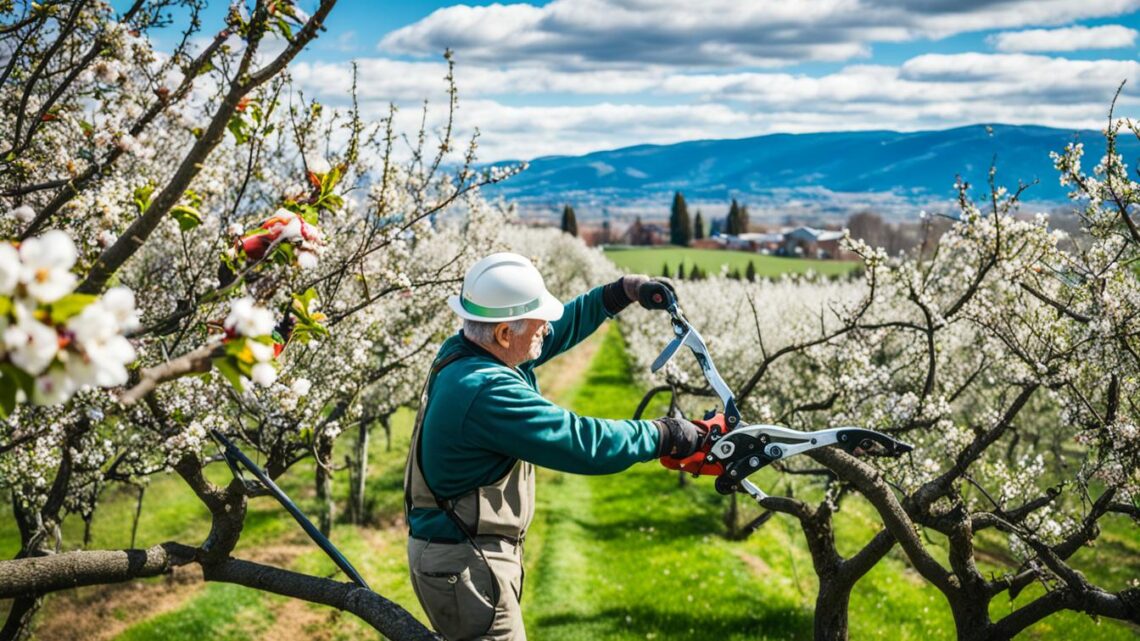
Are you ready to learn how to make your fruit trees thrive? Taking care of these trees needs a plan that covers all year. But, the benefits are huge. This guide will teach you key steps to keep your trees healthy, full of fruit, and free from pests.
We’ll cover everything from spring fertilizing to keeping trees safe in winter. You’ll get expert advice on how to grow more fruit using safe, green methods.
This guide is for everyone, whether you’re new to growing fruit trees or have been doing it for years. It will help you improve how you care for your trees. Get ready to enjoy the tasty fruits of your hard work. Are you ready to start your fruit tree journey? Let’s get started!
Introduction to Seasonal Fruit Tree Maintenance
Keeping a fruit tree orchard healthy needs a proactive plan. Preventative fruit tree maintenance is key for your trees’ health and strength. By watching the seasons and changing your care, you help trees grow well and last longer.
Importance of Preventative Maintenance
Watching your trees closely and fixing problems fast is vital. Trees that are not cared for can get sick or weak. This makes them easy targets for pests and diseases. By being careful and using preventative fruit tree maintenance, you can cut down on pesticides and keep your orchard healthy for a long time.
Benefits of Proper Fruit Tree Care
Putting effort into proper fruit tree care means more fruit and stronger trees. Trees that are well taken care of can handle seasonal changes and pests better. This means you can enjoy their fruit for many years. Plus, the benefits of proper fruit tree maintenance include better tree shape, fighting off diseases, and bigger, tastier fruit.
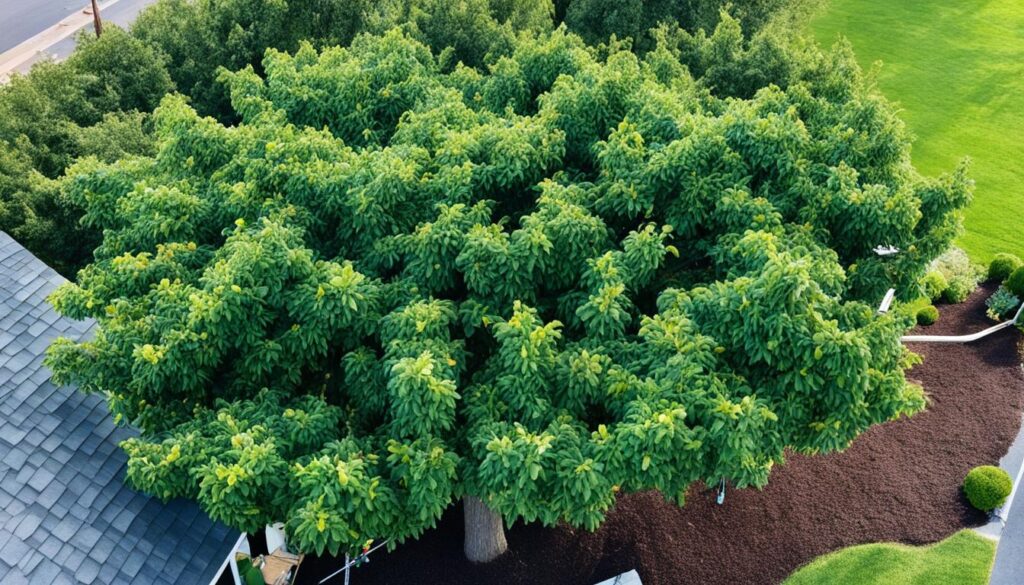
Knowing the importance of fruit tree care and using preventative maintenance helps your fruit tree orchard thrive. It gives you and your family a steady supply of fresh, tasty fruit.
Spring Maintenance for Fruit Trees
Spring is the perfect time to wake up your fruit trees. Start by feeding them with a balanced fertilizer. This helps the soil and gives your trees what they need to grow.
Make sure the soil’s pH is between 6.0 and 6.5. This is when fruit trees grow best.
Pest and Disease Prevention
Use copper sprays to stop diseases like leaf curl and black spot before they start. Also, spray insecticides to keep pests away. Doing this in spring helps prevent big problems later.
Pruning Techniques for Spring
- Prune trees carefully, removing dead, damaged, or crossing branches. This makes the tree strong and well-shaped.
- Don’t prune trees too early in the winter. This can hurt them when it gets cold.
- Pruning in winter helps find and fix problems before they get worse in spring.
Doing the right things in spring, like fertilizing fruit trees, pest and disease prevention in spring, and spring pruning techniques, leads to a great summer harvest. This is what spring fruit tree maintenance is all about.
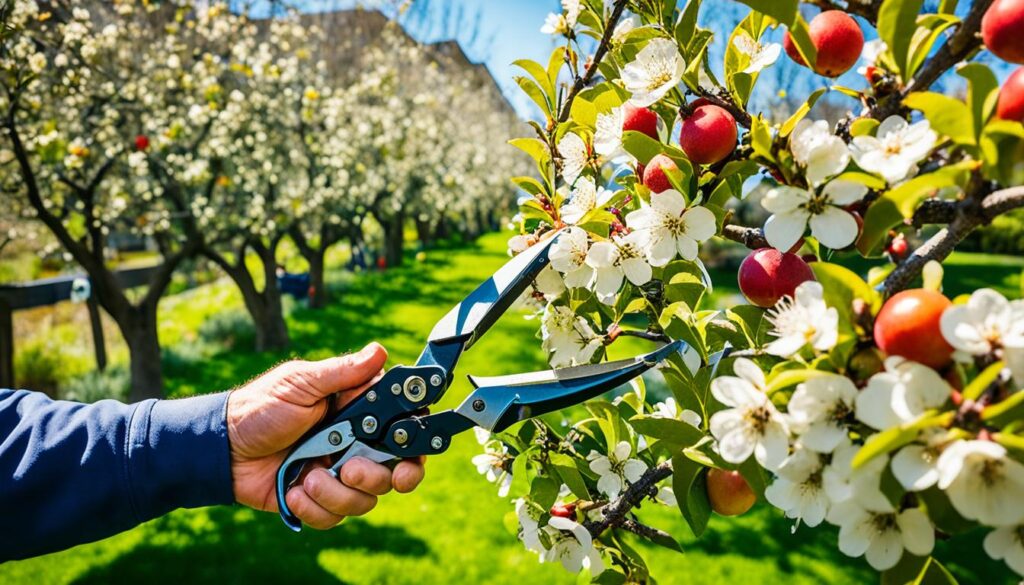
Summer Maintenance for Fruit Trees
As summer gets hotter, it’s key to keep your fruit trees healthy. Proper summer fruit tree maintenance is vital. This means watering them well and keeping pests away for a good harvest.
Mulching and Watering Practices
To fight drought, keep a 2- to 3-inch layer of organic mulch around your trees. This keeps the soil moist and stops weeds. Make sure your trees get enough water, either weekly or every two to three weeks, based on the soil.
For sandy soils, water every one to two weeks, letting the water go 2 feet deep. In clay soils, water every two to three weeks.
Controlling Pests and Diseases in Summer
Watch your trees for pests and diseases like brown rot. Use safe ways to control them quickly. The National Gardening Association suggests pruning new branches before mid-summer. This helps prevent disease and pests.
| Fruit Tree Type | Recommended Shoot Growth |
|---|---|
| Nonbearing Apple Trees | 24 to 36 inches yearly |
| Fruit-producing Apple Trees | 12 to 24 inches yearly |
| Pear Trees (Nonbearing) | 12 to 26 inches yearly |
| Pear Trees (Fruit-producing) | 6 to 12 inches yearly |
| Peach Trees (Nonbearing) | 16 to 24 inches yearly |
| Peach Trees (Fruit-producing) | 10 to 18 inches yearly |
By doing these summer fruit tree maintenance steps, you’ll keep your trees healthy and productive all summer.
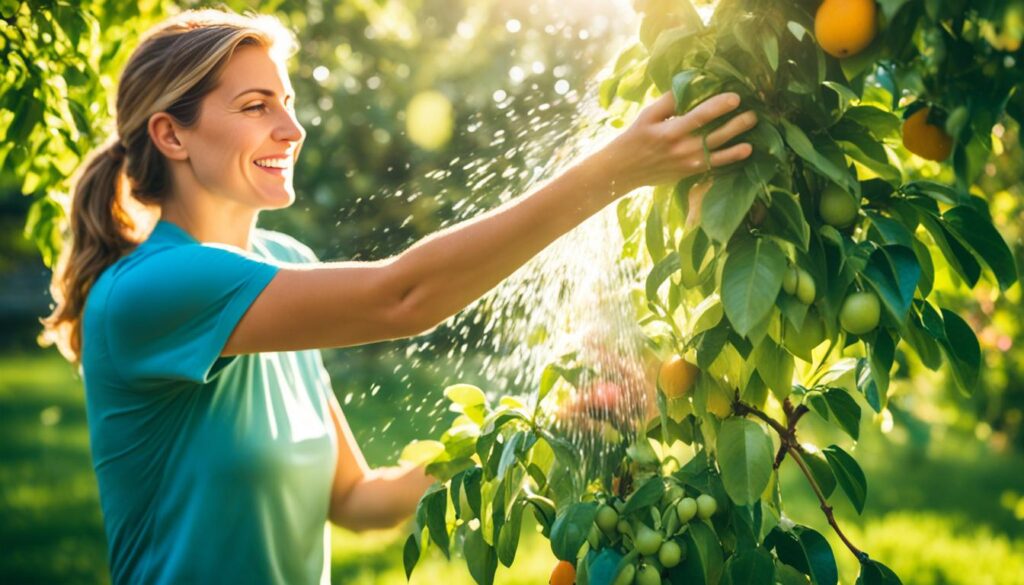
Seasonal Fruit Tree Maintenance
Caring for fruit trees is a job that never stops. Each season has its own tasks to keep your trees healthy. From spring fertilizing and pruning to summer watering and fighting pests, and winter protection. Doing these things right helps your trees grow well and gives you lots of fruit every year.
In spring, it’s key to feed your trees and get the soil ready for growth. Use copper sprays to stop diseases that like warm, wet weather. Pruning in spring also helps shape the tree and encourages new growth.
When summer comes, keeping your trees watered and mulched is important. Watch out for pests like aphids and scale insects. Prune your trees in summer to help them make more fruit.
As the seasons change, your trees need special care for the cold months. Using copper and oil treatments in winter helps them stay healthy for next year.
Looking after your fruit trees all year makes your orchard thrive. Paying attention to what your trees need in each season is key. This way, you’ll get lots of tasty fruit for many years.
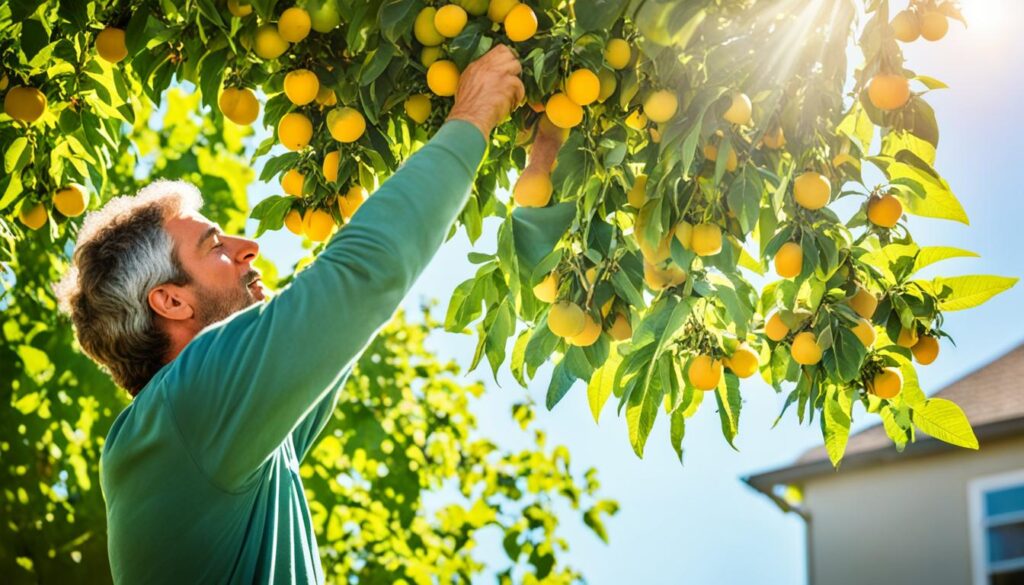
Fall and Winter Maintenance for Fruit Trees
As the growing season ends, get your fruit trees ready for the dormant period. In fall, prune, mulch, and use dormant oil sprays to fight pests and diseases. As winter comes, wrap young trees and insulate roots to protect them from frost and rodents. These steps help your trees start the dormant season strong, ready for a great spring.
Preparing Trees for Dormancy
Getting your fruit trees ready for dormancy is key. Start by pruning them in late fall, cutting dead, damaged, or diseased wood. This boosts the tree’s health and saves energy for the dormant period. Then, mulch around the tree to keep the soil moist and safe from winter.
Wrap young or new trees to protect them from frost and sunscald. This helps a lot in keeping your trees safe in winter. Also, water your trees well until mid-October to help them through the dormant season.
Protecting Trees from Winter Damage
When it gets colder, protect your fruit trees from winter damage. Use a lot of mulch around the roots to keep soil moist and protect roots from freezing. Wrap trunks and lower branches of young trees to guard against frost, sunscald, and rodents.
In areas with lots of snow, clear snow from branches to stop them from breaking. Use an anti-desiccant spray on the leaves to reduce moisture loss and lessen winter damage.
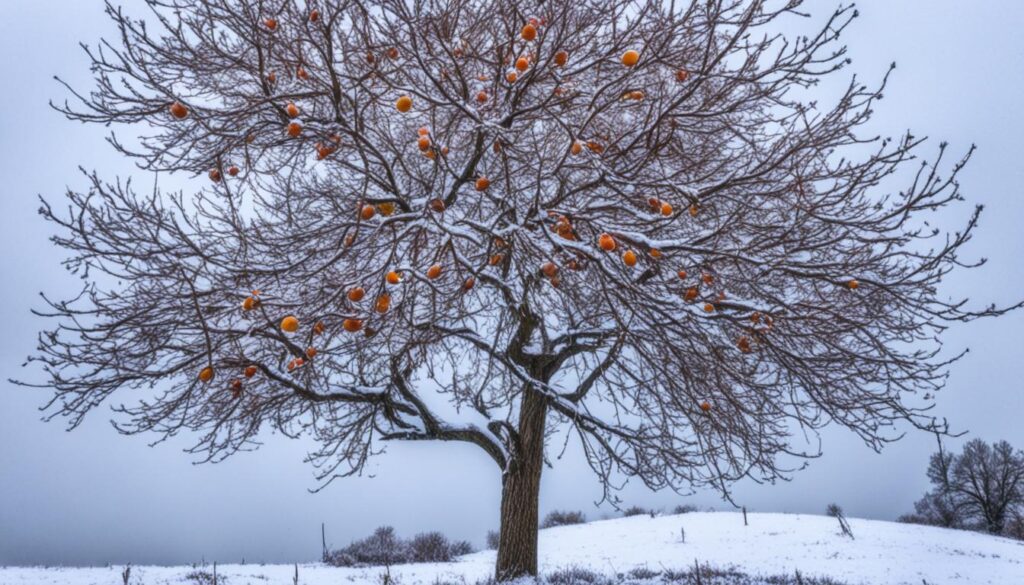
Preparing your fruit trees for dormancy and protecting them from winter pays off in spring. Your hard work will lead to a healthy, fruitful orchard. The effort you put in now will make your trees thrive and produce lots of tasty fruit.
Pruning Techniques for Optimal Fruit Production
Proper pruning keeps your fruit trees healthy and full of fruit. The best way to prune depends on the fruit type and what you want to achieve. By using the right pruning methods, you can get more fruit and better quality.
For pome fruits like apples and pears, prune in the dormant season. This means cutting back branches to make a main leader and thinning out others. It helps make more fruit, bigger fruit, and improves quality.
Stone fruits like peaches, plums, and apricots do well with summer pruning. This method encourages new growth, keeps the tree from getting too big, and lets sunlight reach all parts. Pruning often is key for these trees.
| Fruit Tree Type | Optimal Pruning Time | Pruning Techniques |
|---|---|---|
| Pome Fruits (Apples, Pears) | Dormant Season |
|
| Stone Fruits (Peaches, Plums, Apricots) | Summer |
|
Pruning is key for all fruit trees. It helps get more fruit, makes the tree strong, and lets in more light and air. Knowing what your trees need will help you get a great harvest and keep your orchard healthy.
Pest and Disease Management Strategies
Keeping your fruit trees healthy means watching for pests and diseases. Learn to spot signs of aphids, scale insects, codling moth, and fungal diseases like fire blight and brown rot. This way, you can fix problems fast.
Identifying Common Pests and Diseases
Pests like aphids, scale insects, and codling moths can harm your trees. Fungal diseases, such as fire blight and brown rot, are also common. Look for signs like wilting leaves, discolored fruit, or insects to keep your orchard healthy.
Organic and Natural Control Methods
- Try organic and natural control methods to fight pests and diseases in your fruit trees.
- Dormant oil sprays work well against scale insects and pests that stay in the trees during winter.
- Pheromone traps can break up the mating of some insects, lowering their numbers.
- Having ladybugs and lacewings around can help control aphids and other pests naturally.
Using proactive, sustainable methods is key to keeping your fruit trees healthy and productive. By watching closely and using organic and natural ways to control pests, your orchard will flourish for many years.
Fertilization and Soil Management
Healthy, nutrient-rich soil is key for fruit trees to thrive. It’s important to test the soil often to find the best fertilizer for your trees. Use a balanced, slow-release organic fertilizer in early spring to feed your trees.
Add compost or aged manure to the soil to boost nutrition. This also helps with drainage and holding water, giving your trees what they need for lots of fruit. Mulching and aeration are key for the best fruit production.
| Fruit Crop | Cups of Fertilizer per Year of Tree Age |
|---|---|
| Apples | 1/2 – 2 |
| Pears | 1/2 – 2 |
| Sweet Cherries | 1/2 – 1 |
| Peaches | 1 – 3 |
| Plums | 1/2 – 1 |
| Tart Cherries | 1/2 – 1 |
| Blueberries | 1/2 – 1 |
| Grapes | 1/2 – 1 |
The right amount of fertilizer depends on the fruit type, soil, and tree growth. Talk to a local expert to find the best fruit tree fertilization and soil management for your trees.
Fruit Thinning and Harvesting Practices
Keeping your fruit trees healthy and productive takes work all year. A key step is fruit thinning. This means removing some young fruits early on. It helps the rest grow better.
Thinning is great for many fruits like apples, pears, and peaches. By leaving about 6-8 inches between fruits, they grow bigger and tastier. This also stops branches from breaking and keeps the tree healthy for years.
The best time to thin is in the first 20 days after the flowers fall off. This helps the tree focus on the best fruits. Different fruits need different thinning methods. For example, thin peach trees when the fruits are 3 to 5 inches apart.
When it’s time to harvest, pick when the fruit is ripe. Use gentle hands to avoid damage. With fruit thinning techniques and careful harvesting, you’ll get more and better fruit for years.
Specialized Techniques for Different Fruit Trees
Many fruit tree care tips are the same for all. But, some techniques are special for certain fruits. Knowing how to care for different fruit trees helps you get the best results.
Caring for Stone Fruits
Stone fruits like peaches, nectarines, and plums need extra care in summer. Summer pruning helps prevent disease and keeps air moving. Cutting back some shoots in mature trees makes the fruit bigger and better.
Caring for Pome Fruits
Pome fruits, like apples and pears, do well with pruning in the dormant season. Training these trees to grow with a single leader is good. The best angle for branches is between 45 to 60 degrees.
Some dwarf apples don’t spread much because of their wide limbs. Espalier training lets you grow fruit trees flat, saving garden space. Use galvanized wire for trellises, with the bottom wire about 4 feet off the ground.
Learning how to care for stone and pome fruits helps your trees grow well. This way, you can enjoy a big, healthy harvest.
Seasonal Maintenance Calendar for Fruit Trees
Keeping a fruit tree orchard healthy needs work all year. This calendar helps you keep up with important tasks. It covers everything from pruning in the winter to pest control in the summer. This guide makes sure your trees get the right care at the right time. This leads to a great harvest every season.
In winter, get your trees ready for spring. Prune when they’re dormant and use a spray with 30% copper. Also, make sure the soil is ready for growth. When spring comes, feed your trees and watch for pests and diseases. Use safe ways to control them.
Summer is for keeping trees watered and mulched. Watch out for bugs and diseases. Keep your trees healthy and strong.
As seasons change, keep up with pruning, thinning, and picking fruit. This helps trees grow well and produce more. In fall, clean up leaves, spray for winter, and protect your trees. This calendar helps your fruit trees do great all year, giving you lots of tasty fruit.



